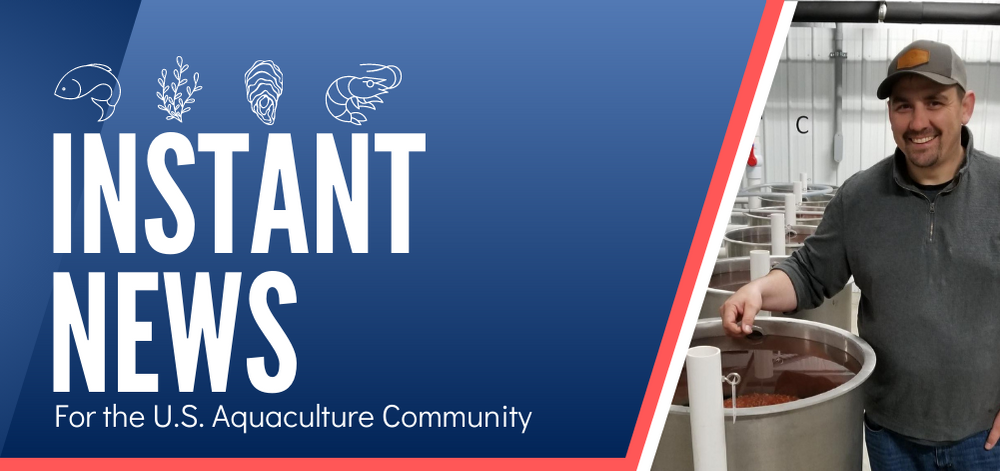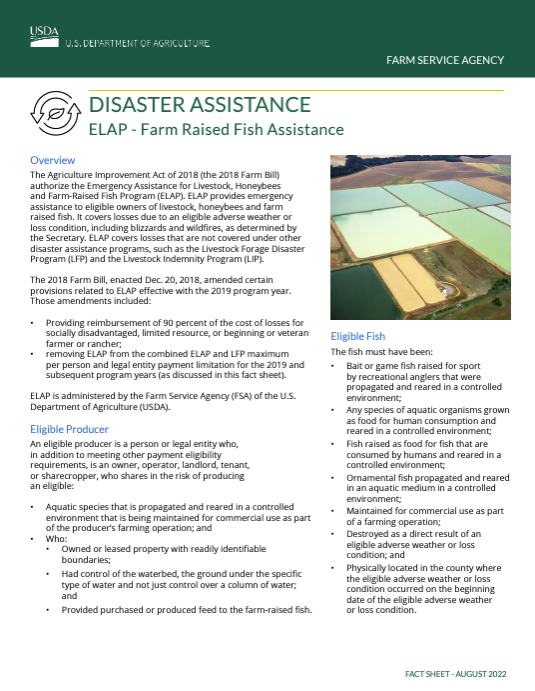|
Our Mission: |
|
|
USDA Makes Producer-Friendly Change to 2023 Notice of Loss Requirements for ELAP |
|
|
|
The U.S. Department of Agriculture (USDA) has waived certain notice of loss requirements for 2023 for the Emergency Assistance for Livestock, Honeybees, and Farm-raised Fish (ELAP). Producers who incurred ELAP-eligible losses in 2023, now have until Jan. 30, 2024 to submit a notice of loss |
|
In an effort to streamline assistance to support access to critical 2023 natural disaster recovery assistance, USDA’s Farm Service Agency (FSA) is waiving the requirement to submit ELAP notices of loss within a pre-determined number of days for 2023. Instead, producers have the flexibility to submit 2023 notices of loss as soon as possible, once losses are realized, following a natural disaster event or no later than the established annual program application for payment deadlines for each program. FSA county committees are also being asked to re-evaluate 2023 ELAP late-filed notices of loss to determine if the waiver applies.
“Our goal is to get producers into these disaster programs, and they are always encouraged to turn in an application if they believe they are eligible,” said FSA Administrator Zach Ducheneaux. “Program improvements are only effective if we ensure producers have sufficient time and information needed to submit their application. The ELAP waivers we are announcing today, in response to historic disasters in 2023, improve efficiencies for producers and our staff, are responsive to feedback about confusion regarding program timelines and are intended to give our staff the time needed to deliver the right support to producers when they need it most. These waivers are also reflective of FSA’s efforts to integrate improvements and accessibility into our policy decisions. It’s critical that we increase awareness of these program flexibilities so all producers can participate.” |
|
|
Emergency Assistance for Livestock, Honeybees, and Farm-raised Fish |
|
ELAP provides recovery assistance to eligible producers of livestock, honeybee, and farm-raised fish losses due to an eligible adverse weather or loss condition, including blizzards, disease, water shortages and wildfires. ELAP covers grazing and feed losses, transportation of water and feed to livestock and hauling livestock to grazing acres. |
|
ELAP also covers certain mortality losses for livestock including honeybees and farm-raised fish as well as honeybee hive losses. ELAP is designed to address losses not covered by other FSA disaster assistance programs. For 2023, FSA is waiving the regulatory requirement for producers who are eligible for ELAP to file a notice of loss with FSA within 30 calendar days from when the loss first became apparent for livestock and farm-raised fish and 15 calendar days for honeybees. Under this waiver, notices of loss are to be completed by the eligible producer and submitted to FSA no later than the annual program application deadline of January 30 following the program year in which the loss occurred. Therefore, producers who incurred ELAP-eligible losses in 2023, will need to submit a notice of loss by Jan. 30, 2024. |
|
|
2023 Disapproved Applications |
|
FSA county committees will review all notices of loss for ELAP that were previously disapproved for the 2023 program year due to late filing and re-evaluate them to determine if the waiver applies. To receive ELAP benefits, producers will still need to file an application for payment by the established program deadline for the 2023 program year. Producers who are unsure about the status of their notice of loss or application for payment, should contact their local FSA county office as soon as possible. |
|
|
Supporting Documentation |
|
Accurate records and loss documentation are critical following disaster events and are required when filing notices of loss with FSA.
Acceptable loss documentation includes:
|
|
|
More Information |
|
The improvements to ELAP build on others made since 2021. This includes ELAP benefits for above normal costs for hauling feed and water to livestock and transporting livestock to other grazing acres during a qualifying drought. FSA also expanded eligible livestock under ELAP, LIP, and the Livestock Forage Disaster Assistance Program, and increased the LIP payment rate for beef, beefalo, bison, and dairy animals less than 250 pounds and most recently beef calves over 800 pounds. Learn about USDA disaster assistance programs on farmers.gov.
On farmers.gov, the Disaster Assistance Discovery Tool, Disaster-at-a-Glance fact sheet and Loan Assistance Tool can help producers and landowners determine disaster protection and recovery program or loan options. For more information about FSA programs, contact your local USDA Service Center.
|
|
to login to the member-only portal. |
|
|
|
Copyright © 2023 National Aquaculture Association, All rights reserved.
Want to update your email notification preferences or unsubscribe? Visit your AquaHub Profile Settings |
|
Contact Us:
Our mailing address is: National Aquaculture Association PO Box 12759 Tallahassee, FL 32317-2759 |




